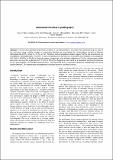Files in this item
Automated chemical crystallography
Item metadata
| dc.contributor.author | Fuller, Amy | |
| dc.contributor.author | Scott-Hayward, Lindesay Alexandra Sarah | |
| dc.contributor.author | Li, Yang | |
| dc.contributor.author | Buehl, Michael | |
| dc.contributor.author | Slawin, Alexandra Martha Zoya | |
| dc.contributor.author | Woollins, J Derek | |
| dc.date.accessioned | 2011-04-01T23:06:03Z | |
| dc.date.available | 2011-04-01T23:06:03Z | |
| dc.date.issued | 2010-04-28 | |
| dc.identifier | 4638185 | |
| dc.identifier | b4c835ee-b9dc-429c-905f-58b35c2f25c8 | |
| dc.identifier | 000276991700063 | |
| dc.identifier | 77952577172 | |
| dc.identifier.citation | Fuller , A , Scott-Hayward , L A S , Li , Y , Buehl , M , Slawin , A M Z & Woollins , J D 2010 , ' Automated chemical crystallography ' , Journal of the American Chemical Society , vol. 132 , no. 16 , pp. 5799-5802 . https://doi.org/10.1021/ja100247y | en |
| dc.identifier.issn | 0002-7863 | |
| dc.identifier.other | ORCID: /0000-0002-1095-7143/work/48131783 | |
| dc.identifier.other | ORCID: /0000-0002-9527-6418/work/56862001 | |
| dc.identifier.other | ORCID: /0000-0002-1498-9652/work/31779257 | |
| dc.identifier.other | ORCID: /0000-0003-3402-533X/work/73700895 | |
| dc.identifier.uri | https://hdl.handle.net/10023/1769 | |
| dc.description.abstract | The first fully automated small-molecule robotic X-ray diffractometer is described. After demonstrating the utility of the instrument using multiple samples of ammonium bitartrate, we investigated the conformational chirality of diphenyl dichalcogenide (E2Ph2, where E = S, Se, or Te). Structural and computational studies suggest that the two enantiomers are energetically indistinguishable. Therefore, it was unsurprising that we found (in 35 suitable data collections) the proportion 0.51:0.49 of M-S2Ph2 to P-S2Ph2 in the bulk sample. Interestingly, after 65 data collections of Te2Ph2, (46 provided suitable data sets), we found the proportion 0.72 +/- 0.13 of M-Te2Ph2, suggesting there could be a statistically significant preference for the M-enantiomer in the sample examined here. We found that Se2Ph2 underwent homochiral crystallization, with all 24 crystals being M. Our experiments may represent a salutary lesson in statistical analysis. | |
| dc.format.extent | 4 | |
| dc.format.extent | 1044711 | |
| dc.language.iso | eng | |
| dc.relation.ispartof | Journal of the American Chemical Society | en |
| dc.subject | Absolute-configuration | en |
| dc.subject | Crystal-structure | en |
| dc.subject | Crystallization | en |
| dc.subject | Dichalcogenides | en |
| dc.subject | QD Chemistry | en |
| dc.subject.lcc | QD | en |
| dc.title | Automated chemical crystallography | en |
| dc.type | Journal article | en |
| dc.contributor.sponsor | EPSRC | en |
| dc.contributor.institution | University of St Andrews. School of Biology | en |
| dc.contributor.institution | University of St Andrews. School of Chemistry | en |
| dc.contributor.institution | University of St Andrews. EaSTCHEM | en |
| dc.contributor.institution | University of St Andrews. Centre for Research into Ecological & Environmental Modelling | en |
| dc.identifier.doi | https://doi.org/10.1021/ja100247y | |
| dc.description.status | Peer reviewed | en |
| dc.date.embargoedUntil | 2011-04-02 | |
| dc.identifier.grantnumber | EP/H003517/1 | en |
This item appears in the following Collection(s)
Items in the St Andrews Research Repository are protected by copyright, with all rights reserved, unless otherwise indicated.

